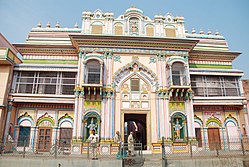Ayodhya
| Ayodhya अयोध्या | ||
|---|---|---|
| Staat: | ||
| Bundesstaat: | Uttar Pradesh | |
| Distrikt: | Ayodhya | |
| Lage: | 26° 48′ N, 82° 12′ O | |
| Höhe: | 95 m | |
| Einwohner: | 55.890 (2011[1]) | |
 | ||


Ayodhya (Hindi:अयोध्या, Ayodhyā) ist eine geschichtsträchtige Stadt im Norden Indiens mit etwa 60.000 Einwohnern. Die alte Hauptstadt von Awadh (Oudh) liegt im Distrikt Ayodhya des Bundesstaates Uttar Pradesh und zählt zu den sieben heiligen Orten des Hinduismus, da dort der Gott Rama geboren sein soll. Ayodhya bildet mit der nur ca. 7 km entfernten Nachbarstadt Faizabad eine gemeinsame kommunale Selbstverwaltung (Hindi: Nagar Palika Parishad, englisch joint municipal board).
Lage und Klima
Die Stadt Ayodhya liegt in der fruchtbaren Gangesebene auf dem Südufer des Flusses Ghaghara in einer Höhe von ca. 95 m. Das Klima ist warm bis heiß; Regen (ca. 1135 mm/Jahr) fällt ganz überwiegend während der sommerlichen Monsunzeit.
Bevölkerung
Ca. 93 % der Einwohner sind Hindus und ca. 6 % sind Moslems; der Rest entfällt auf Sikhs, Buddhisten, Jains und Christen. Männer machen ca. 60 % der Einwohner aus; nur ca. 40 % sind Frauen.[2]
Geschichte
Bereits der alte Name der im 5./6. Jahrhundert v. Chr. entstandenen Stadt lautete Ayodhya, was soviel bedeutet wie „unbesiegbar“ oder „uneinnehmbar“. Spätere Quellen nannten sie Saketa. Unter den Moguln, die hier im Jahr 1528 die – später noch veränderte – Babri-Moschee erbauten, setzte sich langsam die Bezeichnung Oudh oder Oude durch, die von den Briten im Jahr 1816 übernommen wurde. Von 1722 bis 1740 war Ayodhya die Hauptstadt eines unabhängigen Fürstenstaats, dessen Hauptstadt später in das benachbarte Faizabad bzw. nach Lucknow verlegt wurde.
Die Babri-Moschee wurde nach jahrelangen Konflikten am 6. Dezember 1992 von fanatischen Hindus zerstört (siehe: Tempel-Moschee-Kontroverse von Ayodhya); am 5. August 2020 wurde von Ministerpräsident Narendra Modi der Grundstein eines neuen Ram-Tempels gelegt, der am 22. Januar 2024 eingeweiht wurde.
Sehenswürdigkeiten
Trotz des hohen Alters und der religiösen Bedeutung der Stadt sind nahezu alle Sehenswürdigkeiten neueren Datums. Architektonisch sind sie von den Mogulbauten und von kolonialzeitlicher britisch-indischer Architektur beeinflusst.
- Hauptattraktion der Stadt sind die Ghats (Ram ki Paidi) am Ufer der Ghaghara.
- Der prismenartig geformte Brahma Kund ist ein mittelalterlicher Tempelteich und/oder ein Stufenbrunnen.
- Das von 4 Bastionen gerahmte Hanuman Garhi Fort liegt im Stadtzentrum und stammt aus der Mogulzeit.
- Der dem Gott Shiva geweihte Nageshwarnath Temple ist ein bunt bemalter Tempelbau aus der Mitte des 18. Jahrhunderts.
- Auch der Sri Vijayaraghavaji Temple und der Kanak Bhawan Temple entsprechen eher dem neuzeitlichen Geschmacksempfinden.
Söhne und Töchter der Stadt
- Anushka Sharma (* 1988), Schauspielerin
Literatur
- Reinhard Bernbeck, Ulricke Sommer: Politik, Mythos und Archäologie. Ayodhya und der 3. World Archaeology Congress. In: Ethnologisch-Archäologische Zeitschrift 35, 1994, S. 475–498.
- Koenraad Elst: Ayodhya. The case against the temple. Voice of India, New Delhi 2002, ISBN 81-85990-75-1.
- Karl-Heinz Golzio: Der Sturm auf Baburs Moschee – Frontalangriff auf Indiens Demokratie? Über die politischen Implikationen des sogenannten Religionskrieges von Ayodhya. In: Spirita 1, 1993, S. 49–67.
- R. Kalia: Ayodhya. In: Stanley Wolpert (Hrsg.): Encyclopedia of India. Volume 1: A–D. Thomson Gale, Detroit u. a. 2006, ISBN 0-684-31349-9, S. 81f.
- Arvind Sharma (Hrsg.): Hinduism and secularism. After Ayodhya. Palgrave, Basingstoke u. a. 2001, ISBN 0-333-79406-0.
- Michael Schied: Die Evolution einer fundamentalistischen Bewegung im Hinduismus. Der Ayodhya-Konflikt. Phil. Diss. an der Humboldt-Universität zu Berlin. 1992 (PDF)
- Michael Schied: Nationalismus und Fundamentalismus in Indien. Der Ayodhya-Konflikt. VDM-Verlag Müller, Saarbrücken 2008, ISBN 978-3-639-00541-7.
Weblinks
- Ayodhya – Foto + Infos (englisch)
- Ayodhya – Diverse Artikel (englisch)
- Ayodhya and the Research on the Temple of Lord Rama – Infos (englisch)
Einzelnachweise
Auf dieser Seite verwendete Medien
Autor/Urheber: AshwiniKalantri, Lizenz: CC BY-SA 3.0
Location map of India with Indian claimed territories in grey. Equirectangular projection. Strechted by 106.0%. Geographic limits of the map: * N: 37.5° N * S: 5.0° N * W: 67.0° E * E: 99.0° E Made with Natural Earth. Free vector and raster map data @ naturalearthdata.com.
Autor/Urheber: रूही, Lizenz: CC BY-SA 4.0
Ram ki Paidi Ghat, Ayodhya
Autor/Urheber: Shalini Tomar, Lizenz: CC BY-SA 4.0
About the Kanak Bhavan Temple: The ‘Kanak Bhawan’ is the biggest, religiously one of the most important and architecturally an aesthetically built temple dedicated to Lord Ram and his divine consort Sita. It is located in the pilgrim holy town of Ayodhya in the state of Uttar Pradesh of India. This shrine is a marvelous sample of temple architecture and design, and is the most beautiful and attractive structure in Ayodhya. Its magnificence and charm is not only restricted to its external façade, but the deities installed in the sanctum are so beautiful and captivating to behold that one is left dumbfounded and spell-bound once one sees them. The enchantment of the divine view of the consecrated deities and their magnetic pull is of such intensity that the eyes of the beholder are riveted by their beauty, and he finds it difficult to move his eyes away from them. It is something to be experienced and not simply told and read, because the words have their own limitations, and something that has an ethereal and divine dimension cannot be put in shackles by the limitations of words. It becomes a sort of love at first sight when the visitor is compelled in his heart to make a promise to himself that he would come over and over again to experience and soak in this divine glory of the Lord as much as he can.
When the rays of the rising sun as well as that of the setting sun fall on the building, it looks fabulous, it presents a view that is exceptionally captivating and enchanting. The view of the face of the main structure of the temple that faces the sun, i.e. the wall of the main shrine that faces eastward towards the rising sun as seen from the inner courtyard, simply looks wonderful and out of the world as the first rays of the morning sun sprays it with its light. The same thing is experienced during the afternoon hours when the rays of the setting sun light up the walls of the building facing westwards as seen from the same inner courtyard. It’s a paradise of sorts for photo opportunity.
Conceived more as a sprawling palace rather than as a shrine, the Kanak Bhavan Temple resembles magnificent palaces of Bundelkhand and Rajasthan region of India. Its history dates back to Treta Yug when it was gifted by Ram’s step-mother Kaikeyi to him and his consort Sita as a marriage gift. With the passage of time it fell to ruin, and was reconstructed and renovated many times. The first reconstruction was done by Ram’s son Kusha in the beginning of Dwapar Yug, again by King Rishabdeo in middle of Dwapar, and Lord Krishna is said to have visited the ancient site in pre-Kali Yug era 614.
In the current Yug called the ‘Kali Yug’, it was first built by Chandra Gupta Vikramaditya in Yudisthir era 2431, repaired & renovated by Samudra Gupta in 387 A.D. (V.S. 444), destroyed by Nawab S. Salarjung II Gazi in 1027 A.D. (V.S. 1084) and then finally reconstructed on the ruins & renovated in the present shape by H.H. Maharaja Sri Pratap Singh Ju Deo, G.C.S.I., G.C.I.E. of Orchha and Tikamgarh (Bundelkhand) and his Queen Maharani Vrisbhan Kunwari, and consecrated in 1891 A.D. (V.S. 1948) Vaishkh Shukl 6th, Guru Pushya (roughly the month of May).
There are three pairs of consecrated idols—and all of them are those of Lord Ram and Sita. The largest pair is the one installed by Rani Sri Vrishbhan Kunwari who was the moving force in the construction and establishment of this temple. The pair to its right is of a medium height and is said to be those which were established by King Vikramaaditya and were salvaged from destruction when that ancient temple was destroyed by invaders. The third pair is the smallest and is traditionally believed be the one that was given by Lord Krishna to a woman hermit who was meditating on Lord Ram at this site. Krishna instructed her to bury the idols in the ground when she leaves her mortal coil (body) so that later on they would be discovered and act as a mark to identify the sacred place when a king (who later turned out to be King Vikramaaditya) would set out to resurrect this holy place during Kali Yug. It so happened by providence that when Vikramaaditya was digging the foundation of his temple, this ancient pair emerged, and this helped this great king of India to locate the exact spot to establish the sanctum of his own grand temple.When the current temple was built, all these three pairs were installed in its sanctum sanctorum. All the three pairs are seen now. Due obeisance and worship are offered regularly to all of them daily in the temple.
Autor/Urheber: Bhelki, Lizenz: CC BY-SA 4.0
Vijayraghav Mandir of Ayodhya, one of the most famous Thenkalai Sri Vaishnava establishments of the holy city





